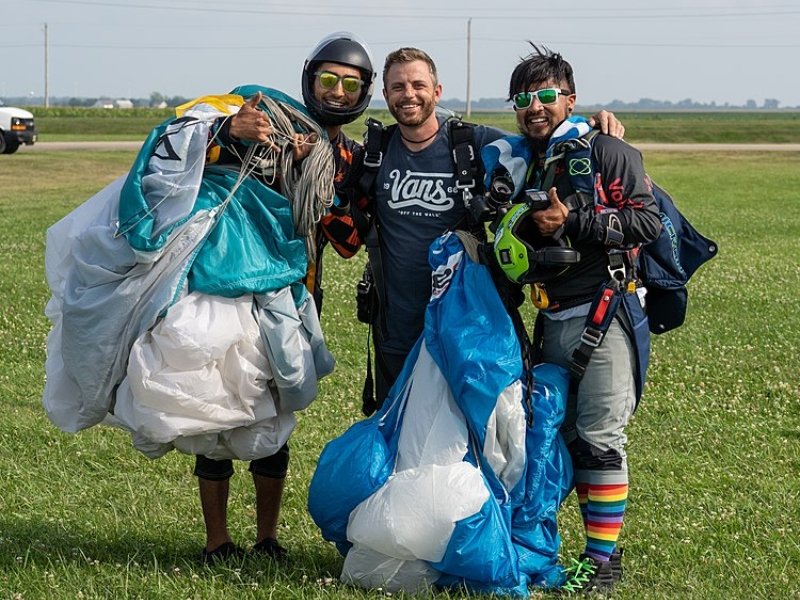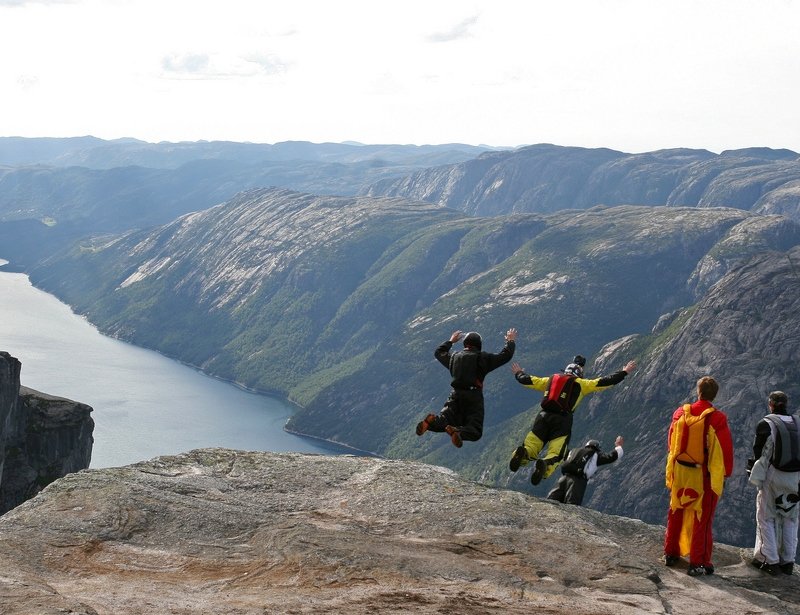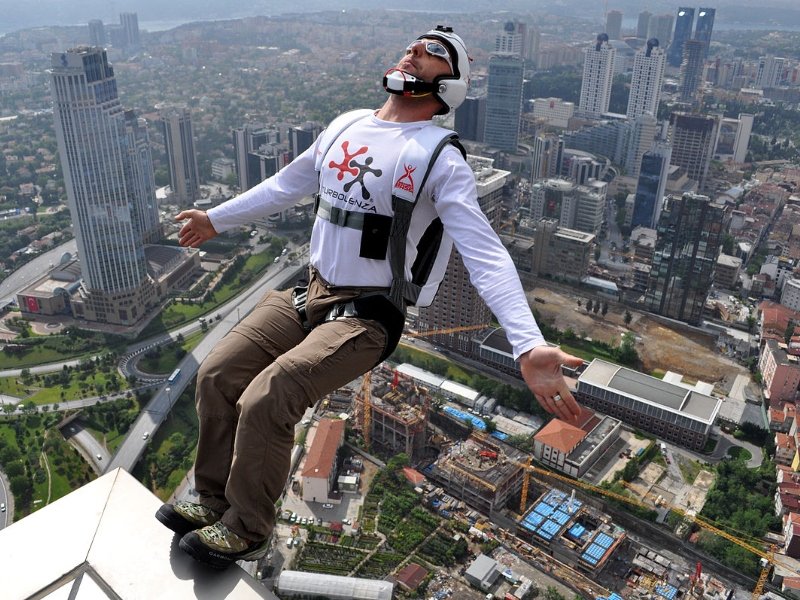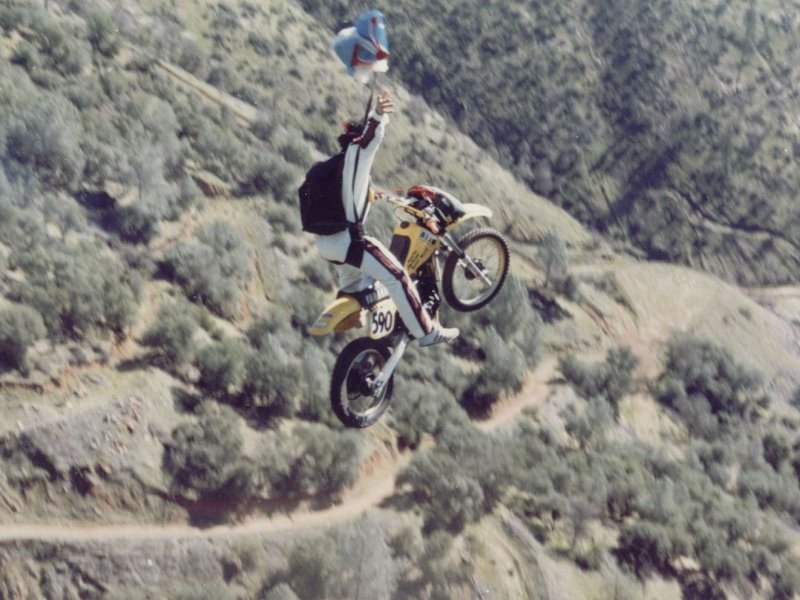One of the most extreme of extreme sports, the majority of skydivers would never even dream of doing a base jump. However, some sports jumpers just have that fearless quality, and the thrills and dangers of base jumping calls to them. With base jumping growing in popularity over the last decade, it’s now possible to consider taking on base jumping as a profession. So how do you become a professional base jumper?
It’s not something the average person or even the average skydiver can consider. But if you have a genuine talent and passion for the sport, it is now possible to work part-time, or even full time, as a professional base jumper. You just need to have a plan.
Let’s take a look at how to get from a newbie base jumper to a professional level. We will also look at an experienced base jumper’s opportunities and how much you can earn in the sport.
The road to becoming a professional base jumper

In the early days of base jumping, only those with 800+ skydives could consider the sport. Over the years, the recommended number dropped to 500 skydives, and today it’s possible to take a beginner’s base jumping course after only 200 solo skydives. The reduction in the number of recommended skydives has a lot to do with the advances in base jumping technology and safety and the higher quality of base jump training. But with that said, you’re going to need every one of those 200 skydives, and possibly more, before seriously considering starting base jumping.
As a base jumper, you’ll need excellent tracking and canopy control, able to make the correct decisions in a split second. Malfunctions are rare, but they do happen. We recommend building some skydiving experience with 7-cell F-111 canopies before starting your journey into base jumping. If possible, once you know you are heading towards your first base jump, you should make a few skydives with the canopy you intend to use. Building experience of your base jumping canopy in a safe environment can be a massive advantage.
Don’t see 200 skydives as the magic number for you to start base jumping; this is only the minimum. The more skydives you can make before starting base jumping, the easier you will adapt. Learn as much as you can about riser input, practicing riser flares and turns. Get some good experience with crosswinds and downwind jumps, and if possible, gain experience night jumping. Try some lower altitude parachute deployments. All this experience will pay off when you learn to base jump.
Once you have worked your way through the first skydiving licenses and have at least 200 skydives and 18 months of experience, you can then consider taking a base jumping course.
Learning to base jump

Regardless of your skydiving experience, a base jumping course doesn’t head straight to the nearest bridge for a jump; there’s a lot of theory to learn first. First, you’ll head back to the classroom and learn the basics of base jump packing and rigging. If you have the budget and are serious about becoming a skilled base jumper, we recommend taking an entry course with a leading base jumping manufacturer.
Some people skip the first jump courses and head straight to jumping, usually through the mentorship of friends or colleagues. We understand why financially it may be tempting to cut the fees of another course, but we don’t advise it; the top base jumping courses as very detailed and polished, structured to cover every piece of knowledge. As well as learning the techniques, safety, and emergency protocols, you’ll also have access to a range of equipment, and you’ll quickly learn what works best for you.
Pick a course that is well respected and has glowing reviews, especially with regards to safety. While we’ve mentioned 200 skydives being the minimum requirement for most beginner courses, some courses may require 300 to even 500 skydives as a minimum (we see this as a positive and shows they take safety extremely seriously).
There are no standard base jump courses, but we recommend finding one covering around 10 to 14+ days with 20+ jumps. The more theory involved is also a bonus. You may be eager to make your first jump, but if you’ve already spent years making 200+ skydives, you can wait a few more days before base jumping. Confidence is great, but over-confidence can be your worst enemy. Regardless of your skydiving experience and ability, go into your base jumping course, accepting you have a lot to learn. Understanding the significant difference between base jumping and skydiving is crucial for a smooth transition.
How to become a professional base jumper

Completing a beginner’s course doesn’t make you an accomplished base jumper overnight. As with skydiving, your first course is only an introduction to the sport, and expertise can only come with years of experience.
One of the best and safest ways to gain experience and knowledge is to have a mentor. We would consider anyone with 300+ successful base jumps to be a mentor candidate. Like skydiving, base jumping is a proud and close-knit community, and most base jumpers relish the idea of becoming and mentor and being able to pass on their passion and expertise to hungry students. Having a mentor you trust and enjoy learning from will help fast-track your knowledge and expand your skills and techniques.
Once you’re out there jumping on your own, you’ll also want to start building your own gear. Renting gear is a great way to get started, and it may take some time to work out your perfect ring. But as soon as you are regularly jumping, there are a lot of benefits to having your own gear which suits your style and goals.
Above all, the only way to becoming and professional level base jumper is by jumping and training consistently. Base jumping isn’t a hobby you should dip in and out of; the dangers and skill level required means you should never get rusty. If you take a significant period away from the sport, you should take a refresher course before jumping solo again. That should also apply to skydiving. Keep skydiving regularly, as the freefall time and skydiving experience will continue to grow your knowledge and experience and keep you prepared should the unexpected happen.
How much do professional base jumpers make?

While it’s possible to become a professional base jumping performer or competitive athlete, only the absolute elite can achieve this. The base jumpers who get the big sponsorships and get paid to perform stunts and compete in championships are the cream of the crop. It’s always important to have goals and aim high, but if you want to base jump for a living, your best route is as a trainer and instructor.
To start a base jumping instructor career, you should first become affiliated with a jump school. Regardless of your skydiving and base jumping ability, you’re not going to go straight in as a lead instructor. The best route is to start as an assistant skydiving instructor or even as a parachute packer or drop zone administrator. Helping out at drop zones gives you a chance to learn the ropes and see how everything works. Before becoming a base jumping trainer, most base jumping instructors will first become skydiving instructors and gain several years of experience and reputation.
How much you earn as a base jumping instructor can vary depending on the school and your experience. You may start as a part-time assistant or parachute packer and get paid hourly, perhaps $10-15 at first. In some cases, trainee packers and assistants will work in exchange for free jumps to gain experience. If you become a full-time skydiving or base jumping instructor at the professional level, you can earn as much as $50,000 to $70,000 per year, with the most sought-after instructors making over $100,000. And if you become widely respected for your ability, you are likely to receive extra work helping manufacturers test and develop products or even working on stunts for movies and events.

